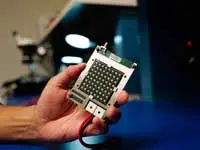Electronics News
Archive : 9 September 2017 год
 Two building blocks launched by Belgian research centre imec are said to be key for future 5G applications. The first is a fast and compact successive approximation A/D converter for consumer electronics applications operating at frequencies of less than 6GHz. The other blocks is a 60GHz front-end with RF phase shifting and on-chip transmit-receive switching. This block is intended to use in 5G fixed wireless access and small cell backhaul applications.
Two building blocks launched by Belgian research centre imec are said to be key for future 5G applications. The first is a fast and compact successive approximation A/D converter for consumer electronics applications operating at frequencies of less than 6GHz. The other blocks is a 60GHz front-end with RF phase shifting and on-chip transmit-receive switching. This block is intended to use in 5G fixed wireless access and small cell backhaul applications.
Wim Van Thillo, imec’s programme director for perceptive systems, said: “Our portfolio includes record-breaking A/D converters, reconfigurable low-noise frequency synthesisers, millimetre wave phased array transceivers, antenna modules and more. These building blocks show state-of-the art performance, excel in low-power operation and are low cost by leveraging scaled CMOS technologies.”
The A/D converter, pictured, which has core area of 350 x 325µm, is fabricated using a 16nm CMOS process. Dynamic power consumption is said to be 3.6mW at 300Msample/s, with a signal to noise and distortion ratio of 70.2dB at 204Msample/s.
Meanwhile, the 60GHz RF front-end features eight way calibration-free beamforming to support a large number of antennas. This, says imec, makes it attractive for fixed wireless access and small cell backhaul applications. On-chip transmit-receive switching allows the antenna array to be shared. With an area of 9.6mm2, the chip is targeted at a 28nm CMOS process. Power consumption is said to be 231mW in receive and 508mW in transmit mode.
Author
Graham Pitcher
Source: www.newelectronics.co.uk
 In a move targeted at speeding the development of 5G networks, Movandi has announced a scalable RF front-end system solution called BeamX. According to the newly launched company, the performance of its RFIC, phased array antenna and beamforming techniques will enable the next generation of 5G and multi-gigabit connectivity.
In a move targeted at speeding the development of 5G networks, Movandi has announced a scalable RF front-end system solution called BeamX. According to the newly launched company, the performance of its RFIC, phased array antenna and beamforming techniques will enable the next generation of 5G and multi-gigabit connectivity.
Maryam Rofougaran, Co-CEO and COO of Movandi, said: “We are looking to develop complete front end solutions for 5G; anything from the interface with broadband to antennas. Our mission is to develop core technology that can access gigabit data rates. We want to make 5G successful.”
The BeamX front-end integrates RF, antenna, beamforming and control algorithms into a modular solution targeted at customer premises equipment, small cell and base station applications. The configurable system support different baseband/modem SoC solutions and can also be used with satellite networks.
“So far,” Rofougaran told New Electronics, “everything has worked at frequencies between 1 and 5GHz. Going from 4G to 5G will be a revolution, particularly when it comes to the front end, where there will be a need for more processing and lower latency. However, when it comes to mm wave technology, the challenges are different and innovation is required to make it work effectively.”
BeamX is a 64 element array designed to operate initially at 28GHz, but will support 39GHz in the near future. It combines RF technology designed in low-cost bulk CMOS with a high efficiency antenna. BeamX is said to achieve ‘breakthrough levels’ of performance and significant range improvements. Rofougaran noted BeamX has a link budget which is ‘4 to 5dB better than other solutions’. “This could double range,” she claimed.
Author
Graham Pitcher
Source: www.newelectronics.co.uk
 A partnership between Groupe PSA and AImotive aims to deliver Level 4 (mind off) autonomous cars capable of attaining speeds of up to 130km/h.
A partnership between Groupe PSA and AImotive aims to deliver Level 4 (mind off) autonomous cars capable of attaining speeds of up to 130km/h.
Via a highway pilot programme based, the project will deploy AI based functionalities, including adaptive cruise control, fully automated lane change, autonomous take-over and collision avoidance. The partners say their objective is to demonstrate the potential of AI for future autonomous highway L4 functionality.
“Testing AI for future Level 4 and Level 5 (driverless) autonomous vehicles is a priority for Groupe PSA,” said Carla Gohin, Groupe PSA’s head, “as these techniques are promising to handle complex situations such as a human driver would do. The collaboration with AImotive gives us the opportunity to make these experimentations in real life conditions.”
Groupe PSA and AImotive completed the first phase of the Highway Pilot project in May 2017, installing the latter’s hardware and software technology into a Citroën C4 Picasso. In the second phase, Groupe PSA and AImotive plan to evaluate the features on a span of 300km dedicated French highway sections. Additionally, simulation software will be used to demonstrate the autonomous driving capabilities virtually, before moving into real-world testing. Thousands of potential driving scenarios on realistically modeled highway sections will be tested across simulated environmental conditions including weather, traffic and lighting.
“A highway pilot was the next step for AImotive, so our partnership with Groupe PSA is an important step toward bringing autonomous driving to market,” said AImotive’s CEO Laszlo Kishonti. “As AImotive continues to move toward fully autonomous Level 5 driving, delivering driver-assisted autonomous functionality is a necessary part of the process, will aid in overall improvement and, eventually, widespread adoption of self-driving.”
Author
Graham Pitcher
Source: www.newelectronics.co.uk

